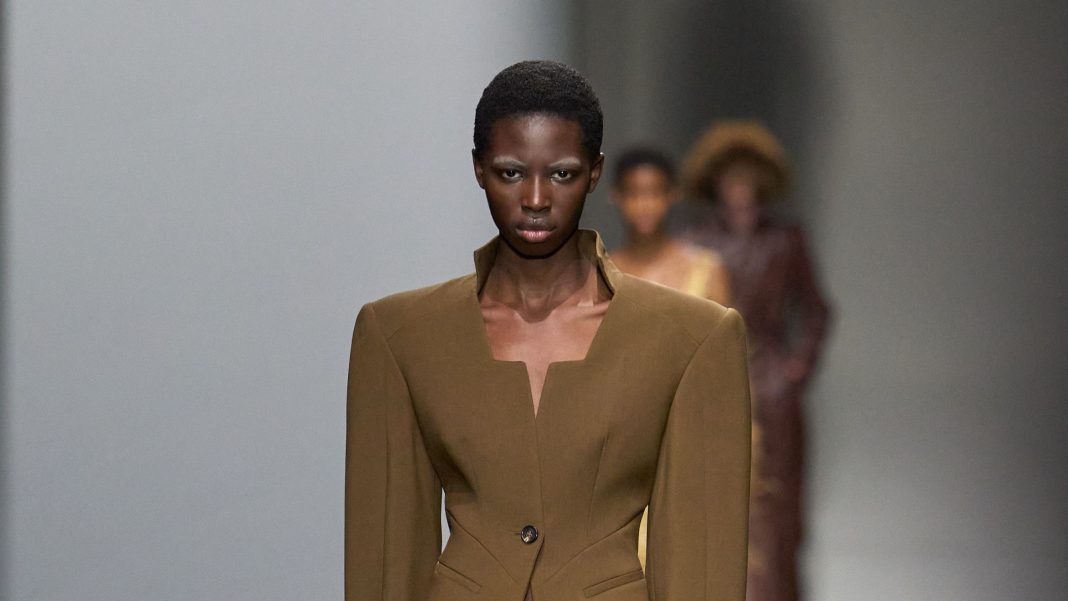Unveiled as ‘Act II’ of an ongoing narrative arc, Giuseppe Di Morabito’s second full scale show, ‘The Fall of Icarus,’ continued the emotional excavation that began last season. If ‘Alone with the Stars’ looked outward, into the future of AI and technological acceleration, this new chapter looked inward: to craft, childhood, memory, and myth. “We’re moving too fast,” Di Morabito said, “And sometimes, you need to fall to find your roots again.” The runway, illuminated by a sun-like circle engineered by artist Nick Verstand, opened on a solitary body floating at its center. The allegory was clear: Icarus, the mythic figure who flew too close to the sun, had crashed. But in Giuseppe Di Morabito’s version of the tale, the fall was not a tragic ending but an origin point for rebirth.
The collection was dense with symbolism, structure, and a dramatic intensity rooted in southern Italian culture. Porcelain bustiers sculpted by hand and embellished with rose bouquets—one of the designer’s recurring emblems—became relics of love and permanence. “The rose has always been with my family,” he said. Pearls encrusted across jersey and lace evoked church traditions and maternal iconography. Crochet, a reference to baby blankets and bedspreads of Di Morabito’s native Calabria, was made entirely by hand, some even by his own mother.
Material experimentation pushed the boundaries of what could be defined as fabric. Stocking-like garments cut from women’s tights were submerged for two nights in a chemical solution until crystals of salt formed directly on their surfaces. “It’s like growing coral,” the designer explained, already envisioning future experiments. Developed in partnership with chemist Sumeyya Donmez, the pieces formed a kind of capsule within the collection, clearly marked on their inner labels. Saline-fused garments carried a vulnerability that contrasted with more armored silhouettes, another staple of the young brand. There were resin corsets molded to the body, sculptural draping that mimicked wet fabric frozen in time, macramé wired with siliconed cords encrusted with rhinestones, and metallic wings that recalled the Icarus myth.
Throughout the collection, the tension between delicacy and strength was core. Shoulders were often dropped while sculpted basques gave structure. Draped wedge boots that were once in leather were now revived in silk to emulate classical antiquity. Baseball caps were entirely feathered in turkey plumes sourced from the food chain, and opera-length gloves were reimagined as handbags. Porcelain earrings mirrored the shape of roses and rhinestones became wings. Latex shorts referenced the sheen of ceramic: “The materials aren’t just decorative,” said Di Morabito. “They’re meant to feel like relics, something you dig up from a place you once knew.” Color was deployed with precision in a palette of white, black, nude, and deep red.
The final scene sealed the myth: a model helped the fallen Icarus rise again, and together they ascended slowly, lit from above, as the sun sculpture hovered around them. “Icarus doesn’t die,” the designer insisted. “He comes back. He burns and then flies again.” If his last show introduced Di Morabito to the Milan Fashion Week calendar, this one marked a declaration: the runway is not a seasonal obligation, but a stage for operatic storytelling. Thinking about shifting to a single, yearly performance, Giuseppe Di Morabito claimed a kind of freedom rooted in the sustainability of craft, time, and creativity. “It’s no longer about seasons, it is about acts: about building one story, year after year,” he concluded. With this second act, the designer merged couture excess with Southern Italian craft and chemical alchemy, forging his own vision of rebirth through clothing.
#Giuseppe #Morabito #Spring #ReadytoWear #Collection


